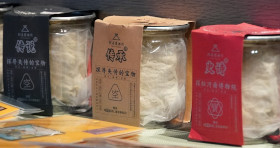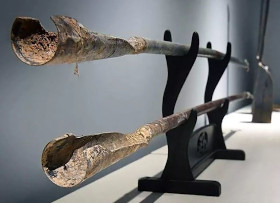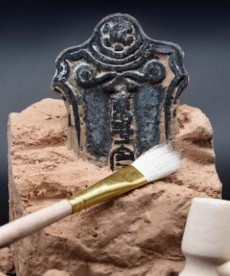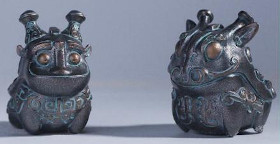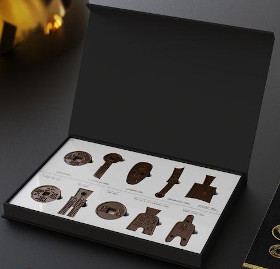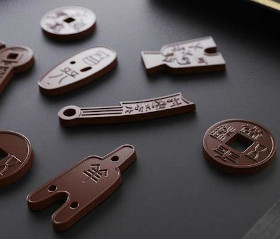For several years, Chinese museums have been offering archaeological blind boxes (考古盲盒) in an effort to promote and popularize archaeology to the general public. These boxes are sold in museum gift shops and are especially popular with the younger generation.
A blind box is a box in which a replica of an ancient cultural artifact is buried. The object is encased in soil or clay. To discover the artifact, one needs to carefully remove the clay in a manner similar to that of an archaeologist unearthing objects in the field.
The outside of the box does not indicate what cultural artifact is “buried” inside. Much of the fun and excitement of these boxes is the surprise of discovery similar to what an archaeologist would experience.
To enhance the reality of the experience, the clay/soil in the box is sometimes the same as that in which the original artifact was found. Also, many blind boxes include a small brush and a digging tool.
A very interesting video shows a Henan Museum staff member “excavating” treasure from a blind box.
The blind boxes from the Henan Museum (河南博物院) in Zhengzhou (郑州) include a small chopstick-sized version of a digging tool known as a “Luoyang shovel” (洛阳铲) which is the traditional tool used in actual archaeological excavations.
The Luoyang shovel, shown at the left, was invented in 1923 by a grave robber from Luoyang.
Mr. Song Hua (宋华), the Director of the Cultural and Creative office (河南博物院文创办主任) of the museum, says that the blind boxes have been offered since 2019 and a brochure introducing items which may be “excavated” is included in each box.
Mr. Song also says that the soil in the Henan Museum blind boxes is mixed with clay from the Mangshan Mountains (阳北邙山) in Luoyang which is where royal mausoleums from many dynasties have been unearthed.
There are a variety of archaeological blind boxes available including ones with replicas of ancient coins, silver ingots (元宝 sycee), seals (图章) of the 12 animals of the Chinese zodiac (生肖), and miniature bronze cooking vessels (gong 觥) from 3,500 years ago.
Other boxes may include replicas of a tiger-shaped tally (虎符) issued to army generals in ancient times, a silver medal (银牌), a bronze mirror (铜鉴), jade ware (玉器) or a small bronze Buddha statue (铜佛).
These blind boxes are extremely popular and can be difficult to buy because they are frequently sold out. Prices start at about $6.15 (40 yuan).
Mr. Song mentions that 600 blind boxes were offered for sale online on December 8, 2020. Even though there was a limit of 3 boxes to a customer, the boxes sold out in 35 seconds. A total of 14,000 boxes were sold in that month alone.
Other Chinese museums also offer blind boxes for sale.
The Shaanxi History Museum (陕西历史博物馆) in Xi’an (西安), where the world renowned terracotta warriors (兵马俑) were discovered, offers blind boxes with a series of bronzeware from the Shang (商朝) and Zhou (周朝) dynasties.
The Sanxingdui Museum (三星堆博物馆), where the ruins of an ancient Bronze Age culture are located, has blind boxes with replica dolls based on its collection of bronze face masks and figurines.
Other museums which sell their own blind boxes are the National Museum of China (中国国家博物馆), the Palace Museum (故宫博物院), the Hebei Museum (河北博物院), the Suzhou Museum (苏州博物馆) and the Shanghai Museum (上海博物馆).
For the Spring Festival (Chinese New Year 春节) in 2021, the Henan Museum offered a special archaeological blind box with replica ancient Chinese coins.
Upon lifting the cover of this blind box, however, one realizes that the replica coins are not encased in clay or require any digging. The coins are already visible.
These ancient coins are made of chocolate (古钱币巧克力) as can be seen in the photo.
Although made of chocolate, these are replicas of actual coins unearthed by archaeologists and now on display at the museum.
There are 10 ‘coins’ in the box representing coinage from the Spring and Autumn period (春秋 770-476 BC), Warring States period (战国 475-221 BC), Western Han (西汉 202 BC – 8 AD), Xin dynasty (新莽 9-23), Northern Qi (北齐 550-577), and Northern Song (北宋 960-1127).
To see specimens of the real coins upon which the chocolate coins are modeled, please see six character knife, gold inlaid knife, three hole spade, spade money, Wang Mang spade money, ant nose money, wuzhu coins, chang ping wu zhu, and Northern Song dynasty coins.
If you enjoy learning about “edible” cultural relics, please also see Chinese Chess Mooncakes.

